Learning Objectives
After this course, readers will be able to:
- Describe which products utilize Acuity Immersion.
- Describe which products utilize Immersion Directionality.
- Describe which configurations are available for the TruLink Remote Control.
Introduction
Over the course of the last year, Starkey has enjoyed a unique partnership with WebMD, one of the most trusted websites on the internet. We contributed content and answered questions for people who have visited WebMD seeking information about hearing-related issues, hearing loss and hearing aids. As part of the partnership, WebMD helped us complete a Healthcare Professional and Hearing Aid Wearer study. Through this study, they found out what many of us already know: the majority of patients believe that hearing aids help them, that they improve their quality of life, and they make them feel more confident in social situations. Furthermore, the study revealed that success is achieved through you -- hearing care professionals providing the services and counseling needed.
With that in mind, we know that the hearing healthcare field is changing. Sometimes the changes are positive, such as the introduction of digital and wireless technology. Other times, the changes are more questionable, like the introduction of personal sound amplification products (PSAPs) or the foray of big box stores into the hearing aid market. Ultimately, we are not certain what the real impact of these changes will be in the long run. We constantly need to be thinking about how we as professionals are going to address these changes, not only in our clinical environment, but also in the greater hearing aid industry. How do we meet the challenges ahead of us and be courageous enough to change with the times?
Reports released last year from the FDA and the President's Council of Advisors on Science and Technology (PCAST) conclude that the leading barriers preventing people from getting help for their hearing impairment are availability and affordability. We at Starkey Hearing Technologies doubt the veracity of these reports. First of all, with regard to availability, the reality is there are over 15,000 places to obtain hearing aids in the United States, with over 90% of people living within 10-15 miles of the nearest location. As it relates to affordability, there are plenty of low cost options for individuals. While there are costlier, premium hearing aids, which include the latest technology, the newest algorithms and the most cutting edge features, those are not the only options. You likely offer your patients high end products, as well as entry level products, and everything in between. If you compare the United States to other countries around the world where hearing aids are "free" (through various governmental healthcare services), the market penetration is not that much greater than it is in the U.S. With respect to availability and affordability, we know that manufacturers have begun reaching out to your patients, offering the ability to order hearing aids online. As hearing care professionals, should we view these manufacturers as a threat, or an opportunity?
You may be aware that congress is now moving forward to create a class of what's known as over-the-counter (OTC) hearing aids. This is going to happen within the next few years. We at Starkey truly believe that the best hearing healthcare is provided by you, the independent hearing healthcare professional. Whether it's in a private practice, an ENT office or at a hospital - we are here to support you. We also believe that in many ways, all of these changes can be perceived as an opportunity for you to provide something that all of these competitors (big box, online and OTC) can't and won't - that is, a custom experience. They can’t provide something that is unique or tailored just for the patient. They can’t provide the custom products that our patients seek. Customization is not a part of their business model. It’s time to provide them with an attractive alternative. We at Starkey want to make sure that we're offering you the best custom options with features that enhance the user's experience.
Top 10 Reasons for Hearing Aid Delight
A number of years ago, Carole Rogin from Hearing Industries Association shared the results from a focus group of dozens of highly satisfied hearing aid users (Taylor & Rogin, 2011). Based on the participant responses, they compiled the top 10 reasons why patients say they are delighted with their hearing aid experience. Of these ten reasons, only one of them has to do with the hearing aid itself; the remainder are related to the hearing care professional. The top ten reasons for patient delight are:
- You, the hearing care professional
- Continued connection
- Verification and validation
- Experimentation
- Strong recommendation
- Counseling
- Evaluation
- Professionalism
- Motivation
- Hearing aids actually work
Note that the number one reason cited for satisfaction is you: the personal connection between the patient and the professional is key for success and delight with hearing aids. Patients are looking to you to provide a strong recommendation, to verify and validate the fittings, and to stay connected to you. It’s about creating an experience in your office. If you take care of the patient relationship, we will make sure you have the excellent technology that your patients need.
MarkeTrak Data
If we carry this idea of providing delight even further, we looked at some data collected by Kochkin and team in MarkeTrak VIII. They examined the relationship between satisfaction with hearing aids and the use of a pre-fitting clinical protocol. Unfortunately, they concluded that the majority of clinicians failed to implement many of the common sense, recommended best practice approaches, such as:
- Custom earmolds/custom fittings
- Positive provider attributes
- Positive office attributes
- Real ear measurements
- Use of pre- and post-fitting questionnaires
- Speech in noise benefit
- Loudness discomfort measures
In addition, their data strongly suggested that the implementation of comprehensive protocols has a major impact on: hearing aid brand loyalty, utility of hearing aids, positive-word-of-mouth advertising, satisfaction with benefit achieved, hearing handicap reduction, hearing aid usage, and reduction of hearing aids in the drawer. Lastly, this research indicated that those not utilizing many of these best practices are vulnerable to disruptive technologies, such as Internet distribution and over-the-counter devices. In this changing environment, we need to take a step back and rethink how we are addressing our patients and their needs for the best hearing possible.
Today's patients are more educated than ever before. Many of us have likely had patients walk into our office in possession of hearing aid research and product information that they found online. Sometimes, they come in requesting a hearing aid that has specific features and capabilities, and they know exactly what it should look like and how it should fit. Many of these patients are looking for a customizable option; something that is personalized to them, not only from a programming perspective, but also from an appearance and fit perspective.
We need to change the way we think about custom devices in the industry and in our fitting approach today. Often, it's easy for us as professionals to do what is efficient, in terms of patient flow, in terms of fitting, and doing what is familiar and comfortable. Unfortunately, the road to excellence and patient delight is not easy or comfortable. In the United States today, the type of hearing aids that are fit the highest percentage of the time are receiver in canal (RIC) BTE hearing aids. There are many cases where BTEs and RIC products are necessary, based on audiogram configuration, power needs, et cetera. However, with advances in manufacturing and in processing, we can offer our patients unique and custom hearing aids. It may require us to re-learn the art of taking impressions, or to re-learn the skills of doing in-office repairs and modifications, such as buffing on hearing aids, opening up vents, replacing broken removal cords. Things that we might perceive as being difficult or time consuming are things that we used to do all the time. Also, for whatever reason, there is a misconception that custom products do not have the premium features and latest technology that RICs and BTE have. We know for a fact at Starkey that that is not true. The same algorithms, features and wireless connectivity are included in our custom products, such as our invisible 13 receiver in-the-canal devices.
Why Starkey?
If you're going to work with custom devices, there is no better manufacturer to work with than Starkey Hearing Technologies. The reputation of the company was built on custom devices. Over the course of the last few decades, we have been providing the best-in-class standard products as well, RICs and BTEs, along with our custom devices. If you're wanting to set yourself apart in this changing market, custom is a unique way to do that. We introduced the CIC product in 1993. We created the invisible in the canal (IIC) product in 2012; a style that all manufacturers have begun to emulate. We build 2000 custom hearing aids every day at Starkey. Of those 2000, over 98% are built as requested by the customer. Again, the average tenure of our technicians who are modeling and building these products is 20 years. We have the experience, the skill, and the know-how to offer to your patients something that these new, emerging approaches and competitors in this changing market can't offer.
About a 18 months ago, Starkey released the revolutionary Synergy platform, the computer processor in our current product line of hearing aids. The Synergy platform set us up for everything that we achieved over the last year and a half, and for what we're currently doing. It provided more power, flexibility, and integration in a smaller, more efficient package to deliver the most advanced hearing solutions for the next generation of patients. Along with the Synergy platform, we also introduced our Acuity operating system. This is the firmware within the hearing aids, which drives all the processing. The power of the Synergy platform allowed our operating system to incorporate patient-preferred wireless technology and quad-core twin compressor technology with features such as Speech Optimization, Music Enhancement, Acuity Lifescape Analyzer, and an extended bandwidth to 10,000 Hz. Less than a year later, we improved upon that operating system and released the second generation: Acuity OS 2. We enhanced the processing power and increased the speed times five, to protect speech and allow for smoother transitions between all of our algorithms, benefitting your patients as they move throughout their ever-changing environments (quiet to noise, to the car, to restaurants, etc.).
A New Dimension in Hearing
In view of all these enhancements, you may be wondering how we could possibly improve on the platform and the operating system? Amazingly, Acuity OS 2 is getting even better. Our R&D team has spent a lot of time collaborating directly with cutting-edge researchers in neuroscience, signal processing, and audiology. We are prepared to deliver a new dimension in hearing, and I am excited to introduce three new product families: Muse iQ, SoundLens Synergy iQ and Halo iQ (Figure 1).

Figure 1. iQ product families.
Please be aware that if you install any firmware updates for the previous product families (Muse, SoundLens Synergy, Halo 2), the hearing aids do not become iQ devices. The iQ features utilize another level of performance in the operating system and in the platform. These are completely new product families; they are not backwards compatible via a firmware update.
First, I'm going to provide a quick overview of what Acuity OS 2 brings to the table. Then, we'll get into the specifics of the iQ enhancements, and the features that lead to patient delight. Finally, we will explain the specific product styles, and some new accessories available for the iQ products.
We introduced Acuity OS 2 in February of 2017, less than a year from the introduction of the first generation. The goal of Acuity OS 2 is to smoothly transition between algorithms as your patient moves around through different listening environments. All of the advanced features of Muse, SoundLens Synergy, and Halo 2 (e.g., speech optimization, directional microphones, wireless technology, music enhancement, frequency lowering, etc.) carry forward into the iQ product families.
There are three new features that we're bringing to the table with the iQ devices:
- Acuity Immersion with e-STAT AI. Acuity Immersion is a brand new, first-of-its-kind algorithm. e-STAT AI is a unique proprietary fitting formula, unique to the Muse iQ CIC and SoundLens Synergy iQ IIC products.
- Acuity Immersion Directionality. This is a new directional microphone approach for all our directional products, particularly RICs and BTEs (devices where we are placing the microphones above the ear).
- Acuity Quiet. This is a noise reduction algorithm that works in conjunction with Expansion to reduce circuit noise and ensure that hearing aids are quiet in quiet environments. Acuity Quiet is in all of the iQ product families, and is not style-dependent.
The first two of these features, each unique in their design, function, and product styles, have a common goal of allowing patients to be immersed in the world around them. First we’ll review Acuity Immersion, and then Acuity Immersion Directionality.
Acuity Immersion with e-STAT AI
This idea of immersion and spatial awareness is extremely important. We live in a three-dimensional, auditory environment. Prior to Acuity Immersion, we haven't had a way to take full advantage of pinna and concha cues. This term spatial hearing has been tossed around in the industry for a while. When a manufacturer claims, "This hearing aid offers spatial hearing," they're referring to directionality, or right/left localization capability. Spatial hearing or immersion is another layer of auditory perception, allowing the wearer to feel present and connected in a particular environment and a particular moment.
Dr. Simon Carlile is our Vice President of Research and head of the Starkey Hearing Research Center in Berkeley, California. He is one of the world's leading experts in the area of spatial hearing. Dr. Carlile defines spatial hearing as "the brain's early warning system, simultaneously sensing all the space around us and provides the feeling of connectedness with the world -- the sense of presence." Spatial hearing moves beyond the ability to discern if a sound is in our right or left ear, or in the middle of our head. It allows the wearer to know where they are in a three-dimensional environment.
Spatial Perception refers to the ability to localize and externalize sound sources. That is, to tell where a sound is, as well as perceive it as coming from outside the ear, rather than in the ear or the head. Localization entails using the natural cues of the outer ear, the pinna and the concha, to identify where a sound is in the three-dimensional space. It is the sense of “externalization” or “presence” in the world. Knowing where a sound, such as someone’s voice, is located in space in relation to other sounds can help the listener to better focus on the sounds around them.
We are all familiar with the concept how the brain uses the binaural cues of interaural time differences (ITD) and interaural level differences (ILD) to help localize sounds. An interaural time difference occurs when sound from a single source arrives at the two ears at different times, depending on the location of the source. It will arrive later at the ear farthest from the sound. An interaural level difference occurs when sound from a single source is at two different levels at the two ears. The head creates a “shadow,” resulting in a softer level at the ear farthest from the sound. These cues are what the brain uses to discern whether someone is on the right side or left side, or whether there is traffic on the right side versus on the left side, etc. These differences allow the brain to determine where in our environment a sound is coming from.
However, there are times when the binaural cues are ambiguous. What happens when the signal reaches both ears at the same time, and at the same intensity? In that case, we are missing the time and the loudness cues that we get when a direct sound comes from the right or from the left. This is where the unique shaping of the outer ear and of the person's torso come into play. Our outer ear, specifically our pinna and concha, filters or shapes the sound as it enters it ear. This filtered response is known as a Head Related Transfer Function (HRTF). Its about how the sound reaches our ears, and what the ear does to that sound. The unique spectral pinna cues from the HRTFs are used by the individual to help identify the location of sounds when the binaural cues are ambiguous. They also provide that sense of externalization, or that sense that sound is come from outside of the head, rather than from inside the head.
When we look at our frequency range (Figure 2), these unique cues are focused from 4000 Hz to 10,000 Hz. A particular person's head related transfer function will have some very unique characteristics specific to them above 4000 Hz up to about 10,000 Hz. Over time, as a person develops and grows, and even as their ear changes shape over time, the brain is able to use and learn these unique head related transfer functions to identify whether a sound is directly in front or behind, above or below, getting a sense of immersion in a three-dimensional soundscape.

Figure 2. Head related transfer function frequency range.
Every person has a unique HRTF, due to differences in individual pinna, head and torso construction. Everyone has a different utilization of these ultra-high frequency cues, which have nothing to do with speech understanding. This is something to be thinking about as we begin to discuss Acuity Immersion. It is not about providing better speech clarity; it is about providing a sense of immersion and true front-back localization, and placing sounds in their correct orientation around the person three-dimensionally.
Although frequently shown as a line, HRTFs are three-dimensional, as the sound source moves around the head. Therefore, we will use a spectrogram to illustrate the pinna’s filter effects measured at points along the midline of the head going from front to back (Figure 3). Frequency is shown on the x-axis, location on the y-axis, and the color indicates the amplitude of the filter effect. Dark red indicates the peaks in the HRTFs and dark blue indicates notches, or valleys, in the HRTFs. The first spectrogram image is typical of a person with normal hearing. The second spectrogram is a representation of what it looks like in a person with hearing loss. Note that most of the prominent spectral differences (the dark red and blue spaces) are in the high frequencies (above approximately 4000 Hz). In particular, the ability of a person to discriminate between front and back, or up and down, and has been shown to depend to a large extent on high-frequency pinna cues. Unfortunately for individuals with hearing loss, they may lose access to those critical high-frequency pinna cues, resulting in a reduced sense of spatial awareness, externalization of sound, and an increase in localization errors. Traditional amplification alone may not be sufficient to make these high-frequency cues audible.
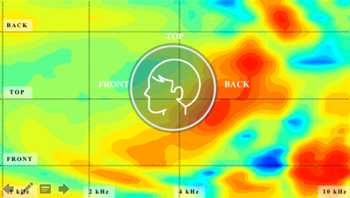
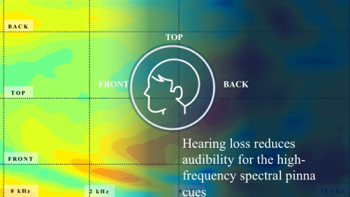
Figure 3. Spectrograms to visualize reduction in audibility for high-frequency spectral pinna cues (normal hearing vs. hearing loss).
Acuity Immersion offers a unique advantage for CICs and IICs. With their microphones ideally situated for picking up sound after filtering by the pinna, these small styles provide the Acuity Immersion algorithm with the important natural cues needed for spatial awareness. Therefore, the Acuity Immersion feature is available only in the Muse iQ CICs and the SoundLens Synergy iQ IICs for mild to moderate hearing losses, and will be enabled by default. The dark gray area in Figure 4 shows the target fitting range. For these particular fittings, we're able to offer another level of perception beyond speech understanding. We want to give patients all the speech audibility that is possible for their hearing loss, and then take it to the next level by reintroducing ultra-high frequency spatial cues to immerse them in their listening environment.
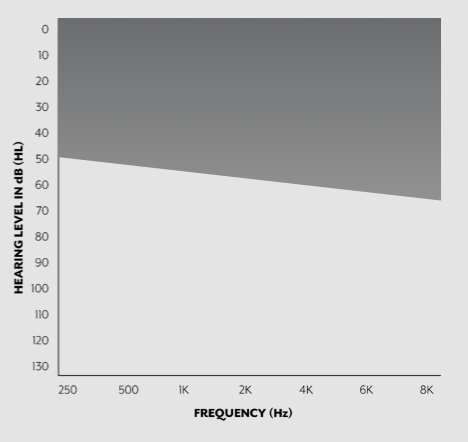
Figure 4. Fitting range for Acuity Immersion.
Figure 5-A is a 3D representation of the head related functions as sound enters the microphone of the CIC or IIC device. Note the prominent peaks in red, and the notches in blue over the frequency region between 4 kHz and 10 kHz, as signified by the dotted lines. Using Acuity Immersion, we're going to break that frequency range down into very fine discreet frequency channels and selectively remove every other channel to redistribute those pinna cues in a slightly lower frequency area, between 4 kHz and 7 kHz (Figure 5-B). When we do that, the peaks and notches of the HRTFs are still evident, but they are in lower frequency locations that will be more audible to the hearing aid wearer. Next, we're going to provide a level of gain to this particular frequency range to reintroduce these high frequency spatial cues to the patient. Note the critical range for speech understanding up to 4 kHz, remains completely untouched by the algorithm (Figure 5-C). We're still providing an appropriate level of gain for audibility and clarity of speech information out to 4 kHz for these patients. However, we are taking a different approach to amplification for these spectral and spatial cues, to reintroduce their brain to information that they've lost due to hearing loss. The result is true spatial immersion, above and beyond speech understandability.
5a.
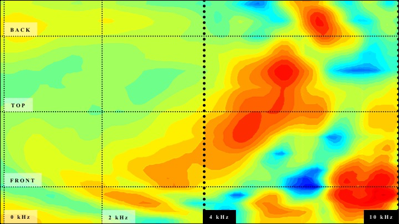
5b.

5c.

Figure 5a-c. How Acuity Immersion works.
Dr. Carlile conducted a study in 2014 which demonstrated that the brain can take newly perceptible spectral cues to relearn spatial relationships and restore the natural sense of presence. In his study, Dr. Carlile put artificial ears on people, in order to change their head related transfer functions. Participants wore these differently shaped ears over the course of several weeks. In the end, they were able to relearn these new cues, resulting in three-dimensional hearing. While research on the underlying mechanisms of spatial ‘remapping’ and recalibration continues, there is clear behavioral evidence that relearning does occur for these spatial cues. With Acuity Immersion, we are going to reintroduce this information to patients with hearing loss, so they can gain spatial awareness and that sense of immersion in the environment.
Acuity Immersion in Inspire
In the Inspire software, when you are fitting a SoundLens Synergy iQ IIC or a Muse iQ CIC, you will need to navigate to the Environment Manager screen to the Acuity Immersion feature, labeled Spatial Hearing (Figure 6). Notice that it takes the place of Directionality, as this feature is only available for CIC and IIC product styles, which do not have directional microphones. This feature can be turned on or off from this screen, and does not have additional adjustable controls. Note that e-STAT AI will be the default fitting formula. It can be enabled or disabled independently in each memory, except: phone, music, streaming, or stream boost memories.
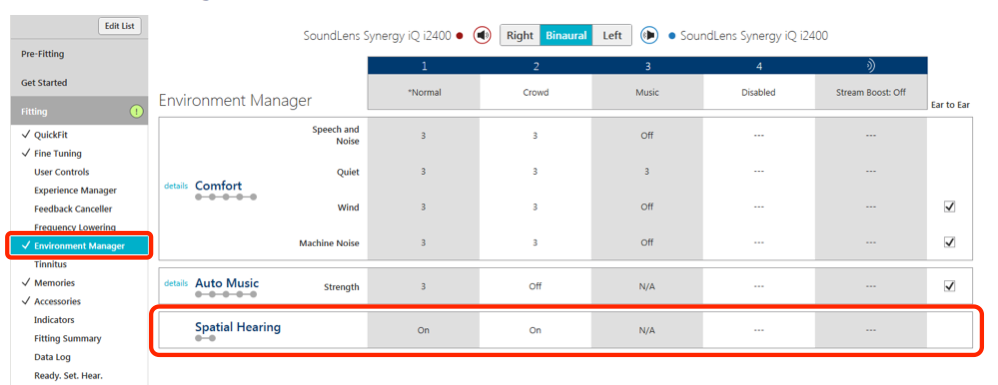
Figure 6. Acuity Immersion in Inspire.
The required fitting formula for the Acuity Immersion feature is e-STAT AI: a UNIQUE, proprietary fitting formula developed by Starkey Hearing Technologies to achieve optimal audibility of the spatial frequency cues (Figure 7). Changing the fitting formula to something other than e-STAT AI will disable Acuity Immersion. When the patient's audiogram lands within that fitting range, and if you're using the specific style of hearing aid, e-STAT AI will become the default formula for that fitting, and Acuity Immersion will be enabled. It is worth noting that e-STAT AI provides slightly more high frequency gain than e-STAT, to ensure that the spatial cues are audible.
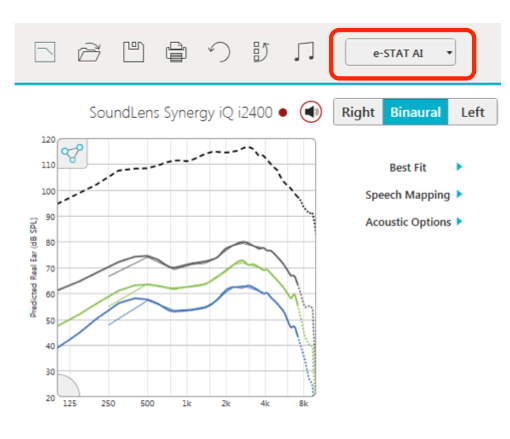
Figure 7. e-STAT AI.
Why did we create a new fitting formula for Acuity Immersion? We wanted to make sure we were maximizing the benefits of these spatial cues. In our validation studies, we allowed patients to wear the spatial hearing products with the traditional e-STAT formula, and also the new AI formula. Patients preferred the sound quality and the new fitting formula of e-STAT AI by a factor of 4 to 1. I'd like to share some of the quotes that we received from participants:
- In all cases, I was able to hear like normal without distractions by the devices.
- The hearing aids become much more valuable to me as the weeks progressed.
- These hearing aids gave me more confidence in my ability to hear conversations going on around me.
As a quick anecdote, someone that I know is wearing these devices. Initially, he wasn't 100% sure what Acuity Immersion was doing. He found that over time, he was no longer having these front-back localization issues, and he regained the ability to pinpoint specific sounds. One day, he was out canoeing on a quiet lake, and he heard a scraping sound. He knew it wasn't coming from his canoe. He was very quickly able to identify that there was another boat about 20 or 30 feet away, scraping against the rock. He was able to pinpoint the sound to that particular location, which he felt he could not have ever have done with his previous hearing aids.
Acuity Immersion Directionality
With RICs and BTEs, Acuity Immersion Directionality focuses on the restoring of natural directivity that is eliminated when we place the microphone over the ear. As soon as we place microphones over the ear, the sound is received into the microphones: not through the pinna, not through the concha, not down into the ear canal. Placing those microphones above the ear eliminates the benefits of the pinna effect, and we lose that natural ear canal resonance.
Natural ear canal resonance (pinna and concha effects) provides a 3-4 dB signal-to-noise ratio improvement, particularly in the high frequencies. I want to play a quick audio recording that was taken through a natural ear with speech coming at 70 dB from the front, and noise at 70 dB from the rear.

We are able to use the natural improvement in high frequencies in a situation like that to be able to focus in on the sound that's coming from the front.
We know that placing a RIC product in the ear will change the ear canal resonance and negatively impact directivity. Here is a recording of the same audio situation, using a RIC product with the microphones above the ear in an omni directional mode. This will simulate what happens when we eliminate that pinna effect.

It becomes more difficult to discern the signal of choice in that scenario, because we've eliminated the high frequency benefit that occurs through the pinna and the concha.
Now, let's listen to that exact same scenario with Acuity Immersion Directionality, where we use our digital processes to provide a directional emphasis for high-frequency sounds, and in the lower frequency region, we maintain an omni directional microphone. Acuity Immersion Directionality restores natural directivity in the high frequencies, improving performance in noise and localization. With the iQ BTEs and RIC devices, in a situation where the hearing aids would make the decision to be in an omni mode, we're going to provide this high frequency directionality, coupled with low frequency omni modalities.
This audio clip utilizes the same auditory configuration of speech in noise, wtih speech to the front and noise to the back with Acuity Immersion Directionality.

As you can hear, it sounds very much the same as the natural pinna effect.
When you're working with these new iQ products, any time the hearing aid (the RIC or the BTE) is in an omni modality based upon the noise level, the signal-to-noise ratio, etc., the hearing aids will have a fixed high frequency directionality and omni directionality in the low frequencies. When they get into an environment where the decision is made to go into an adaptive directional modality, that will perform as it has in the past, making sure we're providing the best SNR based on intensity, location of noise, etc.
There are some additional courses available on AudiologyOnline that are relevant to the content in this webinar. There is course which demonstrates how to use the new Inspire software. Also, we offer a course focused on how you can present yourself as the ear and the hearing expert in your community, moving beyond custom products into other devices, such as hearing conservation products, audio products, etc.
Acuity Quiet
The last iQ feature is what we refer to as Acuity Quiet. Again, the goal is always to make sure that our hearing aids are as quiet as possible when they need to be. We want to ensure that a patient can enjoy those quiet moments without hearing low-level noise inputs, such as the hum of the refrigerator, the computer fan, or the air-conditioning running in the background. It should be quiet when the hearing aids need to be quiet. Traditionally, manufacturers achieve this through the use of expansion, which is what we have done prior to this new feature. In the programming software, if you go to the Environment Manager screen, you would see a feature that was called Quiet, and which was our channel independent expansion approach to make sure we weren't providing gain for low-level sounds.
With Acuity Quiet, we're coupling traditional expansion with our patented fast-acting noise management feature that looks at SNR on a frequency channel independent basis, and can attack noise between speech, between words, between syllables. In the past, we've used that approach above a 50 dB signal input. What we're doing now is also using that for low level inputs. We've got expansion working; at the same time at low levels, we've got our fast-acting speech and noise algorithm working. These two are working in conjunction with each other, to minimize any gain for being provided to low level sounds that could become bothersome, and to make sure the hearing aids have the lowest noise floor possible. In short, expansion was good, but Acuity Quiet makes hearing aids quieter in low level environments than what was possible with expansion alone.
In terms of validation for Acuity Quiet, we had a group of normal hearing subjects listen to our hearing aids in quiet situations. They wore hearing aids with expansion alone, and compared them to hearing aids with Acuity Quiet. Overwhelmingly, 94% of them indicated that those with the Acuity Quiet feature were more pleasant to listen than the hearing aids with expansion alone. We guarantee that these hearing aids have the quietest sound floor and will provide the most pleasant experience when your patients are in quiet situations.
When you're in the software, you won't see anything different. In the Environment Manager, you will still see that Quiet feature, which you adjust in the manner as you did before. However, just know that you're moving beyond expansion and that you are also working with our new Acuity Quiet feature.
There are couple of other new things that we've added for patient delight. With our iQ products, we now offer the ability to use word-specific speech indicators for memory changes. Instead of changing the memory by saying "one, two, three, four," you can customize it to include meaningful words for up to four memory environments. For example, you can say "golf" for an outdoor memory; you can say "pub" for a restaurant memory; you can say "kitchen" for someone who's in a noisy environment. You've got a lot of flexibility to personalize and customize these memory indicators for easier identification and application.
To the Muse iQ and SoundLens Synergy iQ products, we are also adding Smart VC, which allows the volume control to be channel independent. Smart VC offers increased dB in available channels, even if a channel is maxed out, allowing users to receive expected volume gains. You're not going to be limited by the matrix as much as you used to be in the past, and the patient is going to get maximum flexibility out of their VC.
iQ Products and Accessories
Lastly, let's wrap up by summarizing the products styles and accessories that are available in the three iQ product families: Muse iQ, Halo iQ, and SoundLens Synergy iQ.
Muse iQ
Muse iQ is kind of the "workhorse" product family. We offer all styles from CICs all the way up to BTEs. There are three top-tier technology levels: i1600, i2000, and i2400. The new Muse iQ RIC 312t offers a brand new case design and a highly desirable rocker switch. Now you have two receiver in the canal style options and two BTE options to choose from. All standard products include a telecoil and are CROS compatible, and all devices offer Multiflex tinnitus technology and are compatible with our proprietary 900sync wireless protocol and accessories.
Starkey continues to be the world leader in custom hearing aid technology, providing unparalleled expertise in style and function. Our custom Muse iQ products give you full flexibility to offer something unique to the marketplace that many competitors and OTC outfits will not be able to offer. The new Muse iQ custom devices offer a unique edge for patients and professionals, including the following:
- Available in the ITE, ITC, and CIC style options.
- User controls include a push button and/or a digital VC wheel.
- Matrix options extend to 130/70.
- Muse iQ custom ITE and ITC styles offer both telecoil and acoustic phone responses and can be configured for both manual or automatic access (this will be an orderable option).
- The CIC style has options for both manual or automatic acoustic phone access.
- All Muse iQ custom products also offer a field replaceable microphone cover.
- Everything can be programmed either wireless using the SurfLink programmer or using non-wireless programmers (Starkey’s proprietary Speedport, universal Hi Pro or Noah Link). Non-wireless programming requires the use of a flex strip.
- CICs continue to be available in a non-wireless option when necessary for size constraints.
Halo iQ
Halo iQ is available in two styles: a RIC 13 with a push button and a RIC 312 with a rocker switch. The RIC 13 also has a telecoil. The top three technology tiers are available, all of which have tinnitus technology, and utilize our TruLink wireless connectivity with our TruLink mobile app.
SoundLens Synergy iQ
Starkey introduced and invented the invisible in-the-canal product. SoundLens Synergy iQ has full wireless capability in the i2400 technology level. You do have non-wireless capability in the three technology levels, as well as tinnitus technology available in all of them. Additionally, the SoundLens Synergy iQ and the Muse iQ take advantage of the world's first true spatial hearing algorithm, Acuity Immersion.
Wireless
When it comes to wireless technology, with the Muse iQ and the SoundLens Synergy iQ wireless, you have full advantage of all of our SurfLink accessories: the remote microphone, the SurfLink mini mobile, the remote control, SurfLink mobile and the SurfLink media. Fully compatible with all of the new 900 Sync iQ products (Muse iQ and SoundLens Synergy iQ). For Halo iQ, we've got full connectivity with our TruLink mobile app, available for Android and iPhone, and also compatible with Apple Watch.
TruLink Remote
We're introducing a new accessory for Halo iQ: the TruLink remote (Figure 8). This is very similar to the SurfLink remote, but it works on the 2.4 GHz platform. It's available in both the advanced and the basic configuration. It does not need to be charged, as it has a three- to five-year battery life.
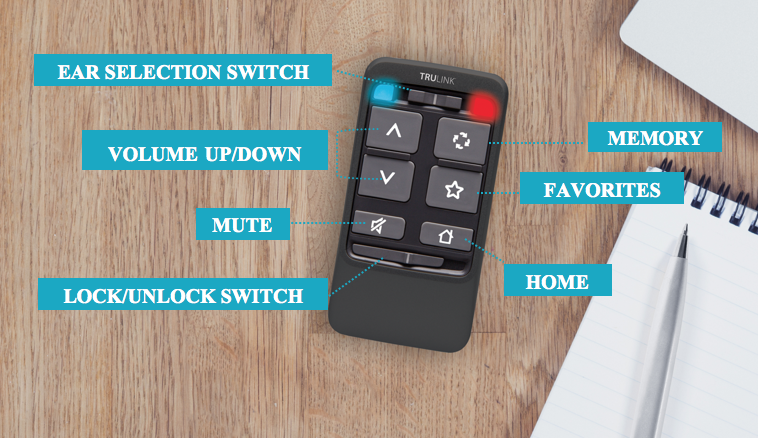
Figure 8. TruLink remote.
Why consider a TruLink Remote Control for your patient? Easy to use buttons make it a great solution for patients who may struggle with the program button onboard their hearing aids, or want an alternative to only using a smart device to adjust their Halo iQs. The remote control also provides a quick and discreet solution when use of a smart device might not be desirable or appropriate. It will also be a good option for patients who do not have a smart device, or the one they have is not compatible with the TruLink App. Patients without a high-tech phone can still enjoy the high-tech quality of Halo iQs.
The advanced configuration of the TruLink remote, offers the following adjustment capabilities:
- Volume up/down
- Mute
- Memory
- Favorites (Configuration options: None, Comfort Boost, Jump to Memory 4, Tinnitus on/off)
- Home (Memory 1, use gain)
To pair the hearing aids, you would quickly lock and then unlock the remote. You would close the battery doors on the hearing aids and make sure they're within 12 inches of the remote control, and then press and hold the home button for 5 seconds. Then the LED lights are going to start rapidly blinking. That means it's in search pairing mode. Once it finds those the right and the left hearing aids, the blue and the red lights are going to flash solid for a few seconds to let you know that they've been successfully paired. The Ear Selection Switch blinks red and blue in unison for binaural changes, or one or the other for monaural changes. For monaural fittings, the Ear Selection Switch is ignored, and the appropriate side will send the correct left or right command. The lock/unlock slider prohibits adjustments and preserves battery life in the locked position.
In summary, Figure 9 provides a visual overview of all of Starkey's wireless solutions for the unique needs of each of your patients. For the Muse iQ and SoundLens Synergy iQ, you have all of the 900 Sync accessories. For the Halo iQ, you have the TruLink mobile app, Apple Watch, and now, the TruLink remote control as well.

Figure 12. Wireless solutions and accessories.
Of course, these products are all driven by the new version of Inspire, our fitting software. Inspire is required to program the iQ products, and to enable the TruLink remote control on the new accessory screen in the Halo iQ fittings. The updated version of Inspire will allow you access to the new speech indicators for the Smart VC. There are also some new reports that you are able to print for your patient, such as the new device guide, audiogram reports, and data log reports. We've also expanded our in-situ audiometry feature, so you can test thresholds using a patient's hearing aids as the transducer, all the way out to 8,000 Hz. If you want to learn more about Inspire, there is a recorded course on AudiologyOnline titled, "Inspire: A New Dimension in Fitting Software."
Summary and Conclusion
With iQ, we are changing the landscape by opening up a new dimension in hearing. We're looking beyond what we are able to do with speech understanding. We know we can provide fantastic speech understanding, clarity and audibility. If you're wanting to offer something to your patients that no one else can offer, look for the iQ devices (in particular, Muse iQ CIC and SoundLens Synergy iQ IICs) to bring your patients to a truly immersive environment with their hearing. It's something that you're not going to see anyone else offering in the hearing aid industry. Our iQ devices can bring a patient's delight -- with you and with their hearing aid experience -- to another level.
To conclude, I would like to leave you with some quotes from patients in our clinical trials. These testimonials demonstrate that taking advantage of these new features allowed patients to live their best auditory life.
- They were easy to use and hear surrounding speech.
- I found most of the sounds I heard to be what I expected them to sound like.
- In all cases, I was able to hear like normal without distractions by the device itself.
- They're the best hearing aids and accessories I've ever used.
- Life was just easier.
References
Taylor, B., & Rogin, C. (2011). The top-10 ways to create consumer delight with hearing aids. Hearing Review, 18(7), 10-23.
Citation
Camacho, L. (2017, October). A new dimension in hearing. AudiologyOnline, Article 21291. Retrieved from www.audiologyonline.com


